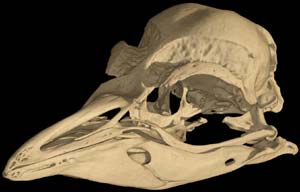The Adelie penguin (Pygoscelis adeliae) is by far the most well studied of all penguins, even though it resides solely in Antarctica (whose Adélie Land gave the birds their name) and various Southern Ocean Islands (the South Shetlands, South Orkneys, Bouvet, Balleny, and Peter Islands). Adelies form the basis for most ecological and behavioral studies performed on penguins. They have one of the simplest coloration patterns of all penguins, with black tops, white undersides, and a white ring of feathers surrounding the eye. They are also fairly small, reaching only about 70 cm in length and 4.5 kg in weight. They eat mainly krill, supplementing their diet with fish and squid during the breeding season (Williams, 1995). |
|
Penguins are entirely aquatic and have evolved numerous associated adaptations, including specialized salt glands (which allow them to drink salt water), extremely flattened wing bones, and a unique system of water-proof feathers (Davis and Renner, 2003). The Adelie penguin belongs to one of the first groups of penguins to evolve, as evidenced by the fact that the Adelie and the emperor are the only two penguin species to live on the Antarctic continent (the probable penguin ancestral area) (Bertelli and Giannini, 2005; Triche, unpubl. data).
Penguins in general (see also Spheniscus demersus, the jackass penguin and Eudyptula minor, the Little Penguin) are highly derived avians with no clear relatives among other living birds, although most studies suggest that they are related to one among a number of seabirds. These possible sister groups include loons (Olson 1985), loons and grebes (Sibley and Ahlquist, 1990; Mayr and Clarke, 2003), or tubenoses (albatrosses and petrels; Simpson, 1946; Livezey and Zuzi, 2001; Bertelli and Giannini, 2005). This confusion is probably due to convergence among seabirds adapted to similar environments and to the fact that penguins evolved over 55 million years ago and have since undergone extreme morphological and genetic modification (Fordyce and Jones, 1990; Tambussi et al., 2005).
Relationships within penguins are also controversial and largely unresolved, although the six living genera almost certainly form natural groups. Adelie penguins lie within the genus Pygoscelis, along with two other species (the chinstrap, P. antarctica, and the gentoo, P. papua). Among other characteristics, these three species share a highly deepened and depressed lower jaw and an elongated antorbital fenestra (Triche, unpubl. data). The pygoscelids were probably one of the earliest groups of penguins to evolve and may be most closely related to the Aptenodytes penguins, the emperor and the king (O’Hara, 1989; Triche, unpubl. data). Within the pygoscelids, the chinstrap and gentoo are probably more closely related to each other than either is to the Adelie, as shown by their similar geographic distributions and head coloration. Adelies also differ from these sister taxa in having an enlarged anterior lower jaw opening and a beak that is slightly shorter than the remainder of the skull (Triche, unpubl. data).
Adelie penguins are not endangered or threatened and currently number around 2.5 million breeding pairs. Their survival, however, does depend on the availability of Antarctic sea ice, on which they breed in the Antarctic summer. Lack of sufficient breeding sites, which may soon be in short supply due to the threat of global warming, may endanger these birds in the future.
Additional Information on the Skull
Click on the thumbnails below for labeled images of the skull in standard anatomical views.

About the Species
This specimen was made available to The University of Texas High-Resolution X-ray CT Facility for scanning by Nina Triche of the UT Department of Geological Sciences. Funding for scanning was provided by a UT Geology Foundation grant to Ms. Triche. Funding for image processing was provided by a National Science Foundation Digital Libraries Initiative grant to Dr. Timothy Rowe of The University of Texas at Austin.

About this Specimen
The specimen was scanned by Matthew Colbert on 14 September 2005 along the coronal axis for a total of 900 slices. Each slice is 0.140 mm thick, with an interslice spacing of 0.140 mm and a field of reconstruction of 66.8 mm.

About the
Scan
Literature
Bertelli, S., and N.P. Giannini. 2005. A phylogeny of extant penguins (Aves: Sphenisciformes) combining morphology and mitochondrial sequences. Cladistics 21:209-239.
Davis, L. S., and M. Renner. 2003. Penguins. Yale University Press, New Haven. 212 pages.
Fordyce, R. E., and C. M. Jones. 1990. Penguin history and new fossil material from New Zealand. Pp. 419-446 in: L. S. Davis, and J. T. Darby (eds), Penguin Biology. Academic Press.
Giannini, N. P., and S. Bertelli. 2004. Phylogeny of extant penguins based on integumentary and breeding characters. The Auk 121:422-434.
Livezey, B, B., and R. L. Zuzi. 2001. Higher-order phylogenetics of modern Aves based on comparative anatomy. Netherlands Journal of Zoology 51:179-205.
Mayr, G., and J. Clarke. 2003. The deep divergences of neornithine birds: a phylogenetic analysis of morphological characters. Cladistics 19:527-553.
O’Hara, R. J. 1989. Systematics and the study of natural history, with an estimate of the phylogeny of the living penguins (Aves: Spheniscidae). Ph.D., Harvard University. 171 pg.
Olson, S. L. 1985. The fossil record of birds. Pp. 79-239 in: D. Farner, J. King, and K. Parkes (eds) Avian Biology vol 8. Academic Press.
Sibley, C. G., and J. E. Ahlquist. 1990. Phylogeny and classification of birds: a study in molecular evolution. Yale University Press, New Haven.
Simpson, G. G. 1946. Fossil penguins. Bulletin of the American Museum of Natural History 87:1-99.
Williams, T. D. 1995. The Penguins. Oxford University Press, Oxford.
Links
Pygoscelis adeliae page from the International Penguin Conservation Work Group
P. adeliae page on the Animal Diversity Web (University of Michigan)

Literature
& Links
Front page image.
|  |

Additional Imagery
 |

